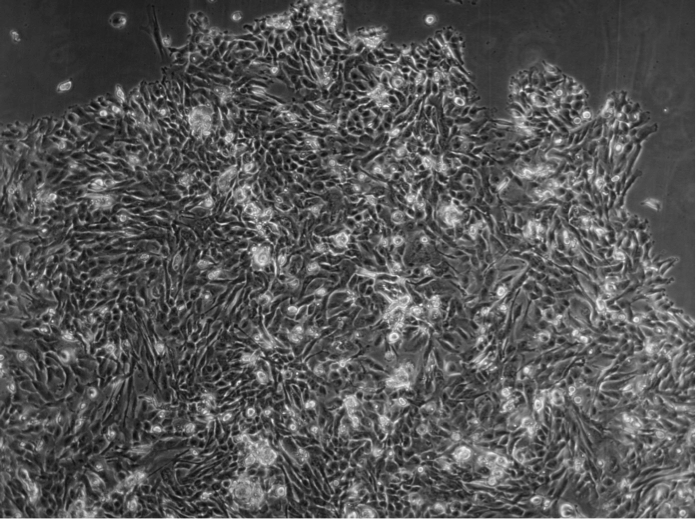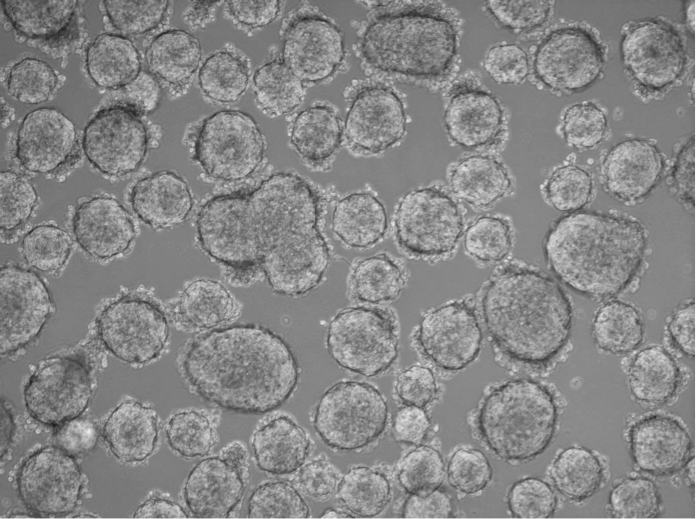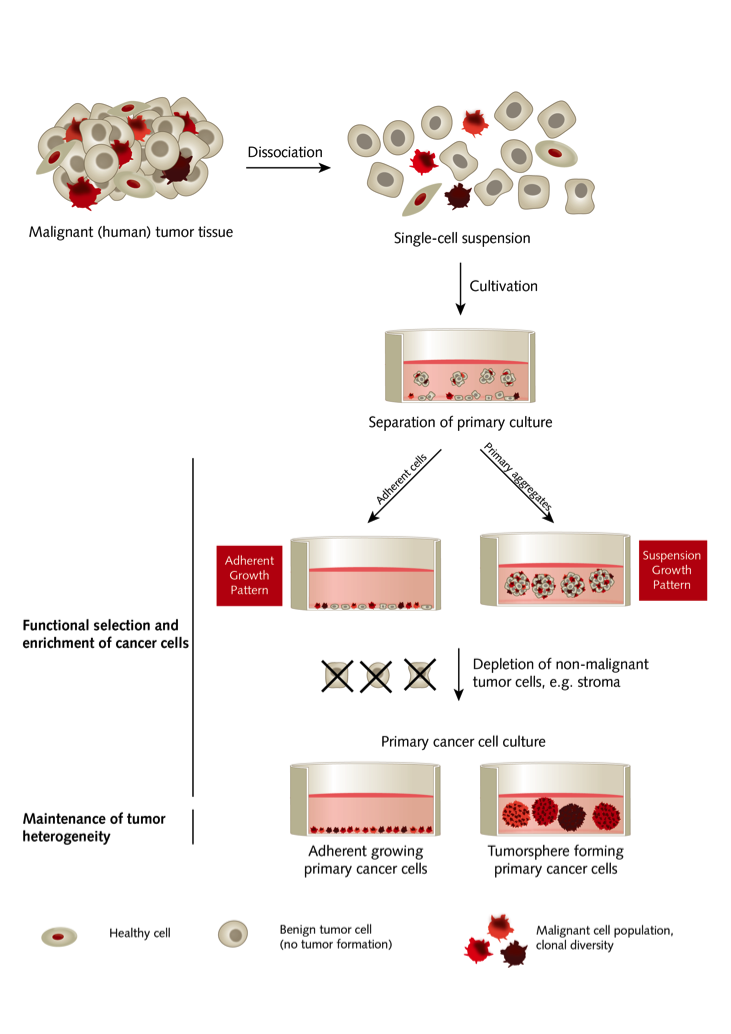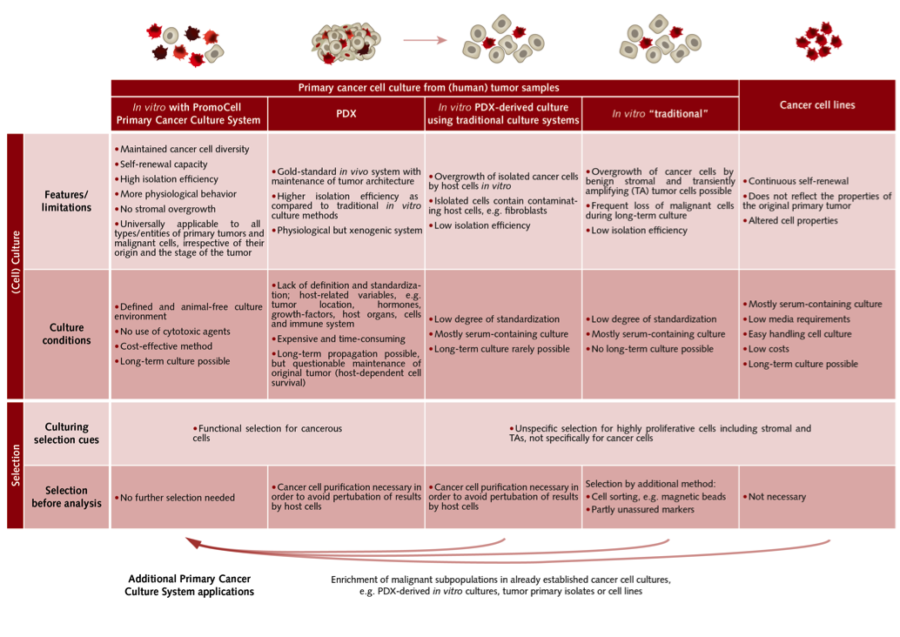Self-destruction of the body: Cancer turns normal body cells into their malignant counterpart that wants to keep on replicating by any means. Understanding the individual disease offers the potential for more effective therapies with fewer side effects. The new PromoCell Primary Cancer Culture System allows researchers to generate high-fidelity in vitro models of primary tumors.

Wide-spread models for cancer research show several limitations
Selecting the optimal drug for each patient requires both profound understanding of the cancer biology and molecular profile, as well as well-established pre-clinical tests. Being able to transfer results from the lab to clinical studies and beyond is crucial (Mitra et al., 2013). “The most accessible and easily usable models for investigating cancer biology and exploring the efficacy of anticancer drugs are immortalized cancer cell lines. But they poorly represent the heterogeneity of tumors in patients, and are therefore not ideal for drug screening,” explains Julia Schnappinger, a postgraduate researcher at the Immunoanalytics Core Facility of the Helmholtz Zentrum in Munich.
Fighting cancer with the body’s own weapons:
Julia Schnappinger at the Helmholtz Zentrum in Munich investigates the properties of tumor-infiltrating lymphocytes in patients with renal cell carcinoma. Her research could lead to new immunological cancer therapies.
Primary Cancer Cell Cultures in Personalized Cancer Therapy
For a patient-specific therapeutic approach, the use of primary cancer cell cultures is gaining more and more relevance. Indeed, it is very valuable for studying the tumor biology, for identifying novel biomarkers, and for testing new compounds. So far, the isolation and culture of solid tumor cells in vitro still represents a critical challenge, and has shown only limited success. Traditional tumor cell media often support the growth of benign tumor cells, and a stromal overgrowth often causes a gradual loss of the original malignant cell population. Moreover, in vitro primary cell cultures are often short-term, and result in a progressive loss of viable tumor cells. “We were trying to establish primary cell cultures from patients with renal cell carcinoma,” says Julia Schnappinger, “but after three to seven days we could observe cancer cells starting to die, and a necrotic area beginning to form in the center of the tumor spheroids. Other groups tried using self-developed conditioned media with supernatants from other cell lines and growth factors. We were looking for an easier and ready-to-use solution that could help us save time and have better success rates.” That’s why Schnappinger has been looking for a culture system that allows her to keep tumor cells in culture for a longer time.
Primary cancer cells from a squamous cell carcinoma in vitro: The primary culture was obtained after 4 weeks as compact and heterogeneous adherent colonies formed by different types of epithelial-like cells. The culture proliferated in the Primary Cancer Culture System with a population doubling time of approximately 7 days and could be serially passaged with no signs of growth inhibition.

Primary cancer cells from a low-grade small cell lung cancer in vitro: The primary isolate was obtained after 4 weeks as a floating sphere-forming culture, which persisted in a near-quiescent state even after 6 months. The culture proliferated in the Primary Cancer Culture System.
The new PromoCell Culture System enables primary cultures of human malignancies
To allow the establishment of long-term cancer cell primary cultures from all types of malignant solid tumors independently of their origin or stage, PromoCell designed the Primary Cancer Culture System. “The development of this culture system took almost two years,” explains Christian Gojak, a cells and media expert at PromoCell. We needed to find factors that favor the growth of tumor cells and limit the expansion of benign cells without causing a selection stress that is too strong.”
This culture system offers a universally applicable and cost-effective solution with a defined and animal-free culture environment without using cytotoxic agents. The culture and the enrichment of malignant cells are supported while the growth of benign cells is not promoted. As a result, culture conditions are selective for cancer cells, while preserving the original diversity of the cancerous subpopulations. The selection is based on functional properties, and subsequent cell sorting is not needed.
“I felt relieved when we started using the PromoCell Primary Cancer Culture System, and we could easily establish primary cancer cell cultures from a patient with renal cell carcinoma. I felt I made a big step forward in my research,” comments Schnappinger. “However, you should still keep an eye on your cancer cells and their growth patterns,” she continues. “Some types build adherent, two dimensional colonies, whereas others build three-dimensional spheres. And cancer cells do not proliferate very fast – the average doubling time is two to three weeks.”
Schnappinger’s application of the Primary Cancer Culture System: She is adding tumor-infiltrating lymphocytes (TILs) to the primary cell culture, letting them migrate into the tumor, and observing eventual changes in the phenotype. The question that fascinates her is to “use the body’s own defenses” and to modulate the patient’s immune system to induce a reaction against the cancer cells. TILs are the effector cells of the immune system in the cancer environment. “It is important to better characterize those cells in patients’ samples, and understand why they are different from circulating lymphocytes and from cells that are present in healthy tissue,” she explains.

Selective culture of primary human cancer cells: The PromoCell Primary Cancer Culture System makes it possible to reliably deplete benign cells from the cell culture while supporting the maintenance of cancer cells and tumor cell heterogeneity.

Pros and Cons of primary cancer cell culture: Comparison of primary cancer cell culture with the Primary Cancer Culture System, patient-derived xenografts (PDX), and cancer cell lines. The biological features and limitations as well as the culture conditions of the different methods of cancer cell culture are contrasted in the table. Furthermore, the differences in selection properties and further applications of the Primary Cancer Culture System are shown.
Upgrade Your Cancer Cell Culture
Isolate tumor cells from patient samples and transform them into long-term cell cultures.
Learn more about the Primary Cancer Culture System and how it compares to other established culture methods.
Related resources


